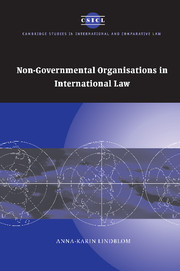10 - Summary and concluding remarks
Published online by Cambridge University Press: 12 August 2009
Summary
The legal status of NGOs in international law
In the first part of this study it was demonstrated that the theories on international law look very differently on the legal role and position of non-state actors. It was argued that it would be more constructive if an examination of the legal status of NGOs could be based on the common elements of such theories, a few basic assumptions that most international lawyers could accept, than if one particular theory was adhered to. The common assumptions that were identified as a platform for the purpose of the study on NGOs were, first, that states are the dominant actors of current international law; second, that they are able to confer legal status on non-state entities; third, that the increasing international role of non-state actors is a fact that international law needs to deal with; and, fourth, that treaties, case-law and resolutions dealing with the procedure of IGOs provide relevant information on the international legal status of NGOs.
Further, an inductive method, or approach to international law, was outlined on the basis of the fundamental assumptions mentioned above. This inductive approach can be summarised as the standpoint that the rules, relations and practices that actually exist ‘on the ground’ are law itself and that, at least sometimes, general rules can be induced from many separate rules.
- Type
- Chapter
- Information
- Non-Governmental Organisations in International Law , pp. 513 - 526Publisher: Cambridge University PressPrint publication year: 2006

